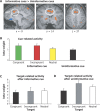Anticipatory activity in anterior cingulate cortex can be independent of conflict and error likelihood
- PMID: 18448644
- PMCID: PMC6670453
- DOI: 10.1523/JNEUROSCI.4400-07.2008
Anticipatory activity in anterior cingulate cortex can be independent of conflict and error likelihood
Abstract
Previous studies have found no agreement on whether anticipatory activity in the anterior cingulate cortex (ACC) reflects upcoming conflict, error likelihood, or actual control adjustments. Using event-related functional magnetic resonance imaging, we investigated the nature of preparatory activity in the ACC. Informative cues told the participants whether an upcoming target would or would not involve conflict in a Stroop-like task. Uninformative cues provided no such information. Behavioral responses were faster after informative than after uninformative cues, indicating cue-based adjustments in control. ACC activity was larger after informative than uninformative cues, as would be expected if the ACC is involved in anticipatory control. Importantly, this activation in the ACC was observed for informative cues even when the information conveyed by the cue was that the upcoming target evokes no response conflict and has low error likelihood. This finding demonstrates that the ACC is involved in anticipatory control processes independent of upcoming response conflict or error likelihood. Moreover, the response of the ACC to the target stimuli was critically dependent on whether the cue was informative or not. ACC activity differed among target conditions after uninformative cues only, indicating ACC involvement in actual control adjustments. Together, these findings argue strongly for a role of the ACC in anticipatory control independent of anticipated conflict and error likelihood, and also show that such control can eliminate conflict-related ACC activity during target processing. Models of frontal cortex conflict-detection and conflict-resolution mechanisms require modification to include consideration of these anticipatory control properties of the ACC.
Figures



References
-
- Baldo JV, Shimamura AP, Prinzmetal W. Mapping symbols to response modalities: interference effects on Stroop-like tasks. Percept Psychophys. 1998;60:427–437. - PubMed
-
- Botvinick M, Braver TS, Barch DM, Carter CS, Cohen JD. Conflict monitoring and cognitive control. Psychol Rev. 2001;108:624–652. - PubMed
-
- Brown JW, Braver TS. Learned predictions of error likelihood in the anterior cingulate cortex. Science. 2005;307:1118–1121. - PubMed
Publication types
MeSH terms
Substances
LinkOut - more resources
Full Text Sources
